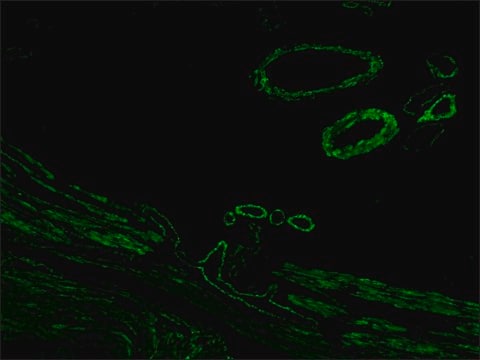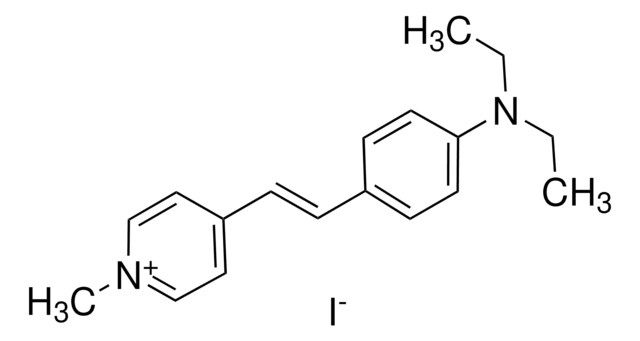S6814
SynaptoGreen™ C4
≥95% purity (HPLC), solid
Synonym(s):
FM1-43, N-(3-triethylammoniumpropyl) -4-(4-(dibutylamino)styryl) pyridinium dibromide, Pyridinium, 4-[2-[4-(dibutylamino)phenyl]ethenyl]- 1-[3-(triethylammonio)propyl]- , dibromide
About This Item
Recommended Products
product name
SynaptoGreen™ C4, ≥95% (HPLC), solid
Quality Level
Assay
≥95% (HPLC)
form
solid
color
dark red
solubility
DMSO: soluble
H2O: soluble
εmax
≥50000 at 507-513 nm in methanol
application(s)
diagnostic assay manufacturing
hematology
histology
storage temp.
−20°C
SMILES string
[Br-].[Br-].CCCCN(CCCC)c1ccc(\C=C\c2cc[n+](CCC[N+](CC)(CC)CC)cc2)cc1
InChI
1S/C30H49N3.2BrH/c1-6-11-23-32(24-12-7-2)30-18-16-28(17-19-30)14-15-29-20-25-31(26-21-29)22-13-27-33(8-3,9-4)10-5;;/h14-21,25-26H,6-13,22-24,27H2,1-5H3;2*1H/q+2;;/p-2
InChI key
VZUVCAGXYLMFEC-UHFFFAOYSA-L
Related Categories
General description
Application
Biochem/physiol Actions
Other Notes
Legal Information
Storage Class Code
11 - Combustible Solids
WGK
WGK 3
Flash Point(F)
Not applicable
Flash Point(C)
Not applicable
Personal Protective Equipment
Regulatory Listings
Regulatory Listings are mainly provided for chemical products. Only limited information can be provided here for non-chemical products. No entry means none of the components are listed. It is the user’s obligation to ensure the safe and legal use of the product.
JAN Code
S6814-VAR:
S6814-5MG:
S6814-BULK:
S6814-5MG-PW:
Choose from one of the most recent versions:
Already Own This Product?
Find documentation for the products that you have recently purchased in the Document Library.
Our team of scientists has experience in all areas of research including Life Science, Material Science, Chemical Synthesis, Chromatography, Analytical and many others.
Contact Technical Service

![2-[4-(Dimethylamino)styryl]-1-ethylpyridinium iodide ≥99% (HPLC), solid](/deepweb/assets/sigmaaldrich/product/structures/352/365/080860c7-fc55-4914-8b9b-0c52847035cb/640/080860c7-fc55-4914-8b9b-0c52847035cb.png)






